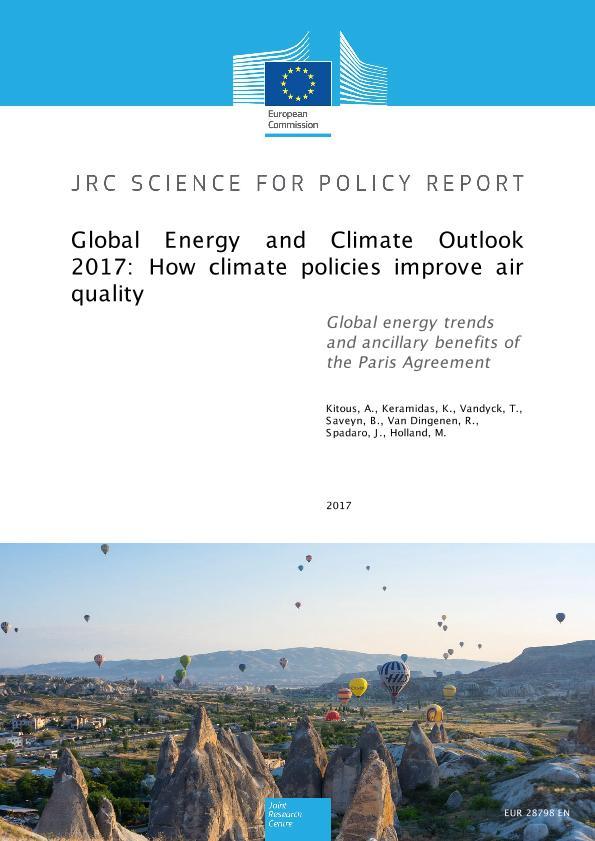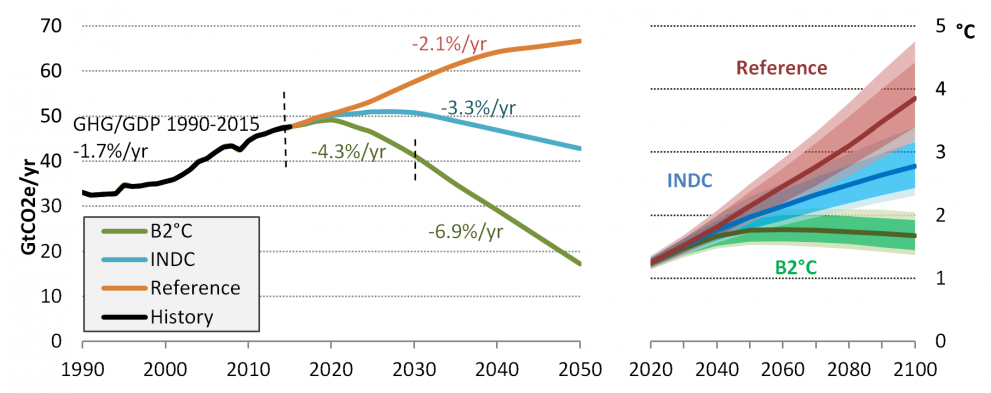
GECO2017 shows that achieving the climate change mitigation target of staying below 2°C temperature rise is possible technically – thanks to an acceleration of decarbonisation trends, an increased electrification of final demand and large changes in the primary energy mix that include a phase out of coal and a reduction of oil and gas – and is consistent with economic growth. It yields co-benefits via improved air quality – including avoided deaths, reduction of respiratory diseases and agricultural productivity improvement – that largely offset the cost of climate change mitigation. These co-benefits arise without extra investment costs and are additional to the benefits of avoiding global warming and its impact on the economy.
GECO2017 examines the evolution of the world energy system and of greenhouse gas emissions to 2050 under several energy and climate policy configurations, using recent policy announcements and energy and economic data, aiming at contributing to the international discussions and to the preparations for the future global stock-taking exercises.
GECO 2017 - Explore the story interactively
Climate policy improves air quality and saves lives
GECO 2017 - Energy and GHG balances
A set of 3 projections with an energy-emissions model - using common socio-economic assumptions
Scenarios assessed
Several economy-energy scenarios to 2050 were developed:
- a Reference scenario, which mostly takes into account all adopted policies for the 2020 time horizon;
- a Below 2°C scenario that aims at respecting the long-term 2°C target with a high probability, implying very rapid action in line with the recommendations of the IPCC AR5 report;
- an INDC scenario that assumes the full implementation of the 2025-2030 country objectives submitted throughout 2015 or updated since.
The study includes:
- An outlook of greenhouse gases emissions, how they evolve across scenarios and what mitigation options are undertaken in each scenario.
- An outlook of the energy markets in the context of climate mitigation policies, including the evolution of primary energy supply, energy supply by fuel, the power sector and final energy demand, along with the evolution of energy prices and investment needs in broad terms for energy supply (and more specifically for the power sector).
- Macro-economic implications of climate mitigation strategies.

Climate policy and air quality
Although the countries' pledges under the Paris Agreement (INDCs) initiate a break with historical GHG trends, reaching the below 2°C target demands a decorrelation of emissions from economic growth by an acceleration of decarbonisation trends from 2020 onwards (energy intensity decrease 5.8% per year on average over 2015-2050 vs. -1.7% per year in 1900-2010), an increased electrification of final demand (35% in 2050 vs. 18% in 2015) and large changes in the primary energy mix (phase out of coal, reduction of oil and gas after 2030; fossil fuels 46% and low carbon including CCS 59% in 2050, vs. 81% and 19% in 2015, respectively).
In addition, GECO2017 explores the synergies between climate policy and air pollution controls to provide opportunities towards a more sustainable future for all. The study shows that mitigating climate change is possible technically, consistent with economic growth, and yields co-benefits via improved air quality that largely offset the cost of climate change mitigation. Co-benefits include avoided deaths, reduction of respiratory diseases and agricultural productivity improvement.
These co-benefits arise without extra investment costs and are additional to the benefits of avoiding global warming and its impact on the economy. They take place in all regions, varying with the ambition level of climate policies and the initial energy mix, and are strongly linked to the reduction of fossil fuel use; they occur locally and in a shorter time frame, providing strong complementary incentives for policymakers to move ahead on ambitious climate action.

The Paris Agreement is estimated to avoid approximately 100,000 air pollution-related deaths annually by 2030 on a global level, of which more than half in China alone. Reaching a GHG trajectory compatible with temperature increases well below 2°C could save roughly 1.5 million lives annually by 2050. In addition to avoided deaths, it also reduces the number of air pollution-related cases of illnesses such as asthma and bronchitis by 15-40% annually by 2050 and raises crop yields by 2.5-6.6%.
By 2030, global air quality co-benefits more than compensate the cost of climate change mitigation policies. This finding is particularly strong for highly polluted fast-growing low income countries relying on coal, and less so for regions with a strong economic dependence on fossil fuel exports (higher mitigation costs) or for countries whose mitigation policy relies heavily on land use measures (lower co-benefits).
